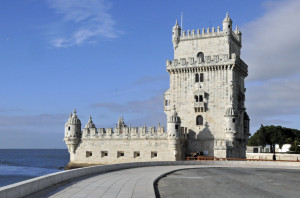The “Tower of Belém” was begun in 1513 when Portugal’s King Manuel I ordered a fortress built on a small island in the Tagus River to defend Lisbon’s busy port. The king also wanted to salute the Order of Christ, successor to the banned Knights Templar, which had financed many voyages of the Portuguese explorers, including those of members Vasco de Gama and Bartholomeu Dias. The limestone fortress, completed in 1519, comprises a hexagonal bastion facing the river, with openings for cannons on five sides, and an adjoining tower, with a chapel and a room for the king.
The two-part structure, officially named the “Tower of St. Vincent” after the patron saint of Lisbon, combined images collected by Portuguese explorers from around the world. The silhouette of the four-story tower section evoked temples of eastern India. The twelve melon-domed turrets for small arms and a loggia with seven arches supported on columns drew on Moorish designs. Representations of exotic animals, including what is said to be first rhinoceros seen in Europe, were carved below the turrets. Crosses of the Order of Christ and pyramid-capped designs copied from Moroccan city walls served as merlons. Nautical rope, manifested in stone, bounded the bastion and tower.
The bastion employed more than thick walls for protection. A large statue of the Virgin Mary holding the infant Jesus faced the river from above the cannon openings, seeking to dissuade enemy ships from firing toward the bastion. The strategy failed. In 1580, Spanish forces under the Duke of Abla captured the fortress and used it to house Portuguese prisoners.
The eclectic style of the Tower of Belém became known as “Manueline,” after King Manuel I, and is considered a transition between Late Gothic and Renaissance architecture. The fortress itself is now a UNESCO World Heritage site and one of the most photographed structures in Portugal.
